Bob Atchison - The Alexander Palace Time Machine Blog
A Romanov Passion for Flowers
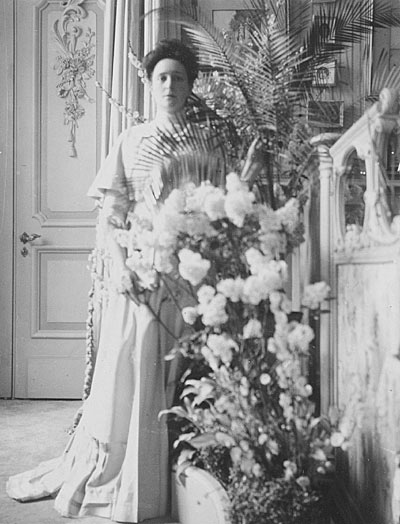 Left: Alexandra stands in the Mauve Room outside the door to the Pallisander Room. To the left of the Empress was a large arched greenhouse-like window which provided sunlight for the plants kept alongside a Louis XVI style screen. This lemonwood carved screen was set with crystal and lined with violet colored silk. It partioned off the location of Alexandra's famous Mauve chaise.
Left: Alexandra stands in the Mauve Room outside the door to the Pallisander Room. To the left of the Empress was a large arched greenhouse-like window which provided sunlight for the plants kept alongside a Louis XVI style screen. This lemonwood carved screen was set with crystal and lined with violet colored silk. It partioned off the location of Alexandra's famous Mauve chaise.
There have been many stories told concerning the Romanovs and their love of flowers. Their fabulous parties at the Winter Palace, with groves of fragrant blooming citrus trees and huge masses of flowers, were legendary. It was not only the size, expense and luxury of the floral display that impressed, just one look outside the palace windows and the snow and ice was proof of Russia's power. It seemed there was nothing the Romanovs could not do, even deny nature itself.
Elsewhere in the Winter Palace, Catherine the Great strolled in her glass-roofed hanging garden where flowers bloomed and birds sang to delight her and impress guests in January.
One famous story about the last Empress, Alexandra, and flowers is an extravagant myth. It has been claimed that masses of expensive flowers were brought weekly by specially heated trains from the French Riviera to Tsarskoe Selo by Imperial command for the Empress's private pleasure. Considering their vast wealth it is not surprising that people believed this story to be true, but almost all of Alexandra's flowers were grown in her own greenhouses. Although she was the richest woman in the world at the time, Alexandra was careful with her own expenses and made sure her accounts of her household were always in order. She always insisted that the Imperial Greenhouses and Farm, we relied upon to supply their needs whenever possible.
For generations before Alexandra the Russian Imperial family had loved flowers. Catherine the Great treasured her roses in Tsarskoe Selo and had special guards assigned to protect them year-round from the harsh climate and accidents. Once an Imperial order had been given it was followed until rescinded. Over a century after Catherine died Nicholas and Alexandra discovered a guard still stationed to protect a long vanished rose of Catherine's.
Maria Feodorovna, the wife of Paul I had a famed garden of lilacs, roses and flowering plants that still exists outside her private rooms at Pavlovsk. Her son, Alexander I, sent roses from Josephine's garden to his mother, including the fragrant, milky-pink-almond colored Souvenir de la Malmaison, a Bourbon named for the French Empress's famous estate known for its enormous rose garden. The famous Rose Pavilion at Pavlovsk was decorated by huge hanging garlands of silk roses.
The imperious Nicholas I, a handsome man whose icy masculine good looks both mesmerised and frightened a young Queen Victoria, was an intimidating ruler and yet, an avid gardener as well. At the Alexander Palace Nicholas would go "off-duty" and indulge in private joys like planting flowering Dutch bulbs around the palace with his own hands. Nothing made him happier than receiving a parcel of of new bulb varieties from his relatives abroad for his flower beds at the Alexander Palace.
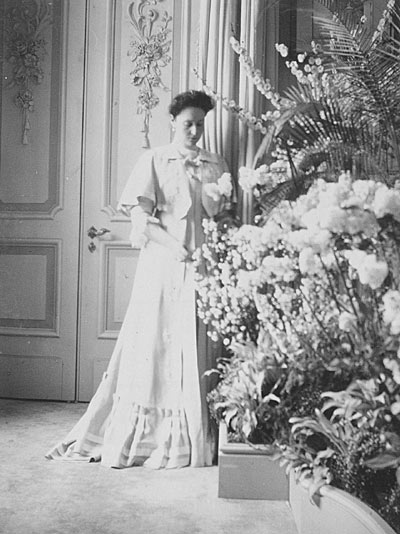 Left: Another picture of the Empress in the Mauve Room with flowering branches, plants and palms. After the revolution museum curators attemped to recreate the atmosphere of the Mauve Room in the time of the Romanovs by reviving the practice of displaying plants from the greenhouses here. Unfortunantely the crowds of people touring the palace made this impossible. This was the only museum in Russia that displayed flowers in their exhibits and many people had never seen flowers like this before, they gawked and touched the flowers smelling their scent, damaging the plants and creeating a traffic jam.
Left: Another picture of the Empress in the Mauve Room with flowering branches, plants and palms. After the revolution museum curators attemped to recreate the atmosphere of the Mauve Room in the time of the Romanovs by reviving the practice of displaying plants from the greenhouses here. Unfortunantely the crowds of people touring the palace made this impossible. This was the only museum in Russia that displayed flowers in their exhibits and many people had never seen flowers like this before, they gawked and touched the flowers smelling their scent, damaging the plants and creeating a traffic jam.
Alexander III gave his wife, the former Danish princess, Maria Feodorovna, the gift of a rose garden alongside her rooms at the Alexander Palace. In the time of the last Tsar, Nicholas II's children loved "Granny's garden", which stood on the bank opposite their private island in the Imperial Park. Adults were not allowed to visit the island with the permission of the children. The "Children's Island" was the location of flower gardens of the Tsarevich and his sisters and here were masses of Lilly-of-the-Valley bouquets of which which the children brought to their mother as gifts.
Alexandra gave gifts of flowers, fruits and plants from the greenghouses to her friends, servants, wounded soldiers, relatives, artists and writers year round. They were delivered by servants in elaborate 18th century costumes. The Empress and her daughters also received dozens of bouquets everyday from people and organizations all over Russia. These flowers, generally decorated with elaborate ribbons with inscriptions, were displayed on tables outside the rooms of the Imperial family. If they wanted they could take the arrangements of their choice into their rooms. Those left behind had their ribbons removed and were displayed in the rooms of the palace or sent to hospitals and churches in Tsarskoe Selo. Everyone who sent flowers to the Imperial family received thank you messages and sometimes gifts in return.
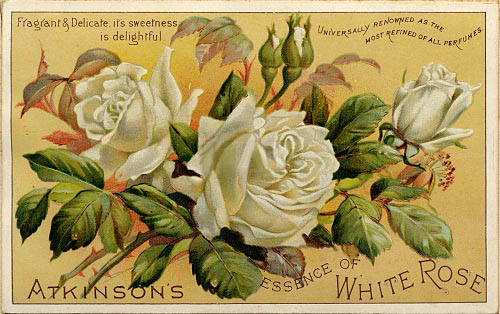 Left: Atkinson's White Rose was Alexandra's favorite scent.
Left: Atkinson's White Rose was Alexandra's favorite scent.
The Empress collected ribbons attached to flowers of special meaning and gathered them in her bedroom on a hook near the door to the Mauve Room.
There was a special room in the basement of the palace where flowers were stored and arranged. Alexandra's personal florist made hand-written cards describing the flowers in the bouquets and baskets they created for the personal apartments of the family. We know the Imperial gardeners grew the well-known roses of the time. The Empress especially liked the white Hybrid Perpetuals Frau Karl Druski, and the pink and richly fragrant Baroness Rothschild.
Garden books and catalogs of plants from Russian garden centers and foreign suppliers were send to the Imperial family and they were avid readers of them. They followed the latest trends in horticulture and ordered plants and seeds. Alexandra and the Dowager Empress Marie was a patron of the flower shows in Russia and abroad, even in England. Other members of the Imperial family were patrons of flower shows and experimental greenhouses in Russia.
The Tsaevich Aleksey had a collection of cactus, with the thorns carefully removed.
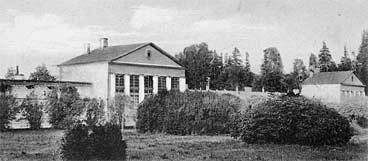 Right: The Imperial Greenhouse in The Alexander park.
Right: The Imperial Greenhouse in The Alexander park.
In the early years of her married life Alexandra spent a great deal of time in the gardens of the Alexander Palace, but her difficult pregnancies and illnesses confined her more and more in her rooms. This was not the only reason for her retreat into her private apartments. It was impossible for her to visit the park without elaborate preparations being made by palace officials and security guards. Alexandra, a shy and private person, felt extremely uncomfortable being watched or stared at by anyone; any visit to the park meant police hidden throughout the park observing her every move. The Imperial family constantly complained about the presence of the police and their efforts to isolate them to no avail.
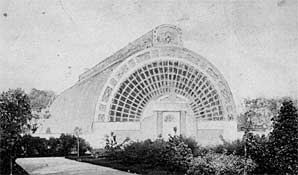 Right: The Imperial greenhouse built by Alexandra.
Right: The Imperial greenhouse built by Alexandra.
As I wrote earlier, Alexandra's flowers came from the Imperial greenhouses near the Alexander Palace. This was not the only source. Other greenhouses belonging to the Imperial court were located in Tsarskoe Selo and were also established at other Romanov estates, like Livadia in the Crimea. The oldest Imperial Greenhouses were designed by the Italian architect Quarenghi, who also designed the Alexander Palace. Alexandra erected a new modern greenhouse with the latest heating, watering and lighting systems of the time near the palace. It had a huge arched glass roof that could accomodate the largest palms.
These greenhouses were huge and by 1910 housed a huge collection of rare and beautiful plants and trees from around the world. Over the years Imperial gardeners had created a vast array of plants from all climates. There were fruit trees, palms of all sizes, berry patches, orchids, bulbs, peonies, flowering shrubs, big rubbery-leaved philodendrons and hundreds of varieties of lilacs in all colors. Russian explorers hunted throughout the world for new types of lilacs and sent samples to the Imperial Greenhouses, where they were carefully nurtured into unique specimen plants.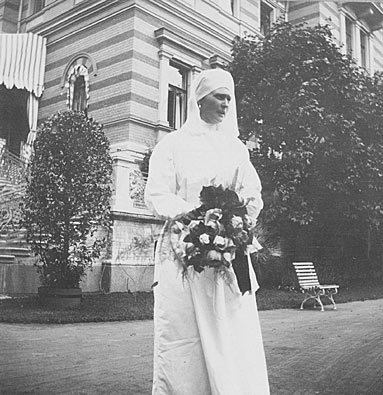 Left: Alexandra in the uniform of a nurse at the Lower Palace in the Alexandria Park at Peterhof. The Empress and her two eldest daughers became nurses during WWI. Here she holds a bouquet of Hybrid Perpetual Roses. Please note the large bush in a planter behind the Empress. This bush was not cold hardy for the St. Petersburg climate and was moved indoors before the first freeze.
Left: Alexandra in the uniform of a nurse at the Lower Palace in the Alexandria Park at Peterhof. The Empress and her two eldest daughers became nurses during WWI. Here she holds a bouquet of Hybrid Perpetual Roses. Please note the large bush in a planter behind the Empress. This bush was not cold hardy for the St. Petersburg climate and was moved indoors before the first freeze.
Alexandra had a special love of lilacs, the color of the Mauve Room was created from a lilac branch the Empress gave to her decorator, Roman Meltzer, to duplicate as the hue for the walls and silk fabrics in her private boudoir. Lilacs come in many colors, some have intense fragrance and others are known more for their unique flower form or shade. The Imperial Greenhouses were able to supply lilacs to the palace almost all year. However the most beautiful, lush and fragrant lilacs came from the Imperial park itself, where huge lilac trees sunk under the weight of blossoms in early summer. The scent was overwhelming. In the far north, in Petersburg and Helsinki, lilacs possess an extra vigor and perfume because of the short growing season and long hours of sunlight during the days of the White Nights.
Beginning in April the Imperial gardeners brought branches from lilac trees in the park to the Greenhouses where they forced early blooming, but they didn't have the size or fragrance of the naturally blooming flowers from the parks. Smaller lilacs, specially grown in pots in the greenhouses were also brought into the palace when they came into bloom. The transportation of potted plants of all types from the greenhouses was an especially dangerous operation. Although the greenhouses were nearby a rare tropical plant - indeed any plant - could freeze during transport in the winter months. To protect the plants as they were moved, special enclosures and heated wagons were created. Dozens of workers were sometimes required to move them.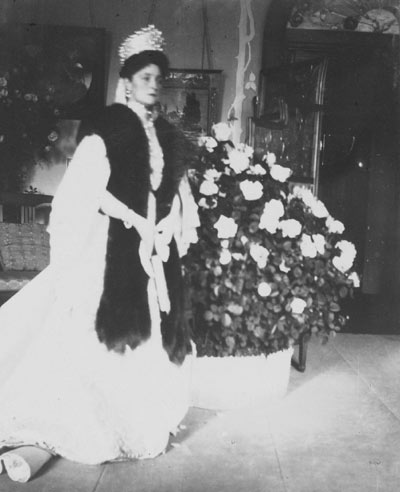 At left is the Empress standing in the Maple Room of the Alexander Palace. She is dressed for a court occasion in a heavy silk gown, expensive sable fur stole and crowned with a jeweled Russian-style headress call a kokoshnik. To the right of Alexandra is a huge bouquet of Hybrid Perpetual or Tea Roses arranged like a living bush. In the left background another arrangement can be seen.
At left is the Empress standing in the Maple Room of the Alexander Palace. She is dressed for a court occasion in a heavy silk gown, expensive sable fur stole and crowned with a jeweled Russian-style headress call a kokoshnik. To the right of Alexandra is a huge bouquet of Hybrid Perpetual or Tea Roses arranged like a living bush. In the left background another arrangement can be seen.
For great parties and events huge palms, flowering citrus trees and great blooming shrubs were brought into the palace. Once they left their transport it was a challenge to get them into the palace. Special hoists were used to lift them through windows. Once inside moving the plants across the polished parquet floors and around expensive porcelain, gilded furniture and treasured works of art could be a frightening experience. Once in place all sorts of special care needed to be taken to protect the plants from changes in temperature, humidity and people.
Every great plant from the Imperial greenhouses was treated by the Imperial gardeners like children. In fact, some of the plants had been given names. Over the generations stories were told about plants, their origins and their history. In 1910 there were 150 year old plants what had first arrived in the greenhouses in the reign of Catherine the Great that were still living and thriving.
Below: Anastasia and Alexis on the Empress's balcony at the old palace at Livadia. A vase of mums stands to the right.
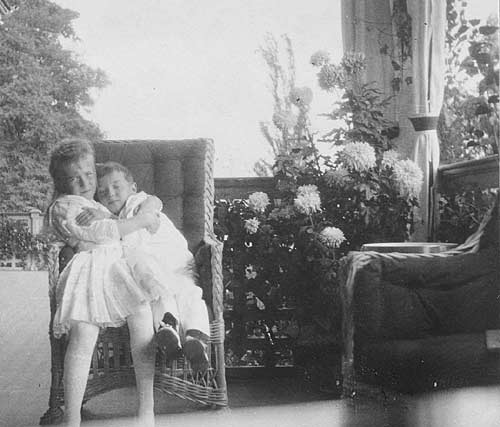


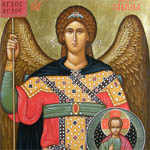



 Imperial Bedroom
Imperial Bedroom Portrait Hall
Portrait Hall Mauve Room
Mauve Room Maple Room
Maple Room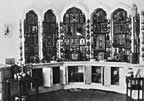 Aleksey's Bedroom
Aleksey's Bedroom Nicholas's Study
Nicholas's Study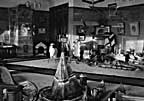 Aleksey's Playroom
Aleksey's Playroom Formal Reception
Formal Reception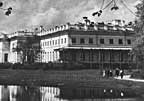 Balcony View
Balcony View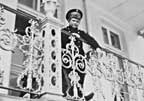 Aleksey- Balcony
Aleksey- Balcony Children-Mauve
Children-Mauve Nicholas's Bathroom
Nicholas's Bathroom Alexandra- Mauve
Alexandra- Mauve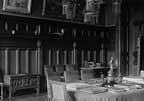 Nicholas's Reception
Nicholas's Reception Tsarskoe Selo Map
Tsarskoe Selo Map